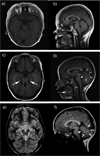Clinical and molecular features of Joubert syndrome and related disorders
- PMID: 19876931
- PMCID: PMC2797758
- DOI: 10.1002/ajmg.c.30229
Clinical and molecular features of Joubert syndrome and related disorders
Abstract
Joubert syndrome (JBTS; OMIM 213300) is a rare, autosomal recessive disorder characterized by a specific congenital malformation of the hindbrain and a broad spectrum of other phenotypic findings that is now known to be caused by defects in the structure and/or function of the primary cilium. The complex hindbrain malformation that is characteristic of JBTS can be identified on axial magnetic resonance imaging and is known as the molar tooth sign (MTS); other diagnostic criteria include intellectual disability, hypotonia, and often, abnormal respiratory pattern and/or abnormal eye movements. In addition, a broad spectrum of other anomalies characterize Joubert syndrome and related disorders (JSRD), and may include retinal dystrophy, ocular coloboma, oral frenulae and tongue tumors, polydactyly, cystic renal disease (including cystic dysplasia or juvenile nephronophthisis), and congenital hepatic fibrosis. The clinical course can be variable, but most children with this condition survive infancy to reach adulthood. At least eight genes cause JSRD, with some genotype-phenotype correlations emerging, including the association between mutations in the MKS3 gene and hepatic fibrosis characteristic of the JSRD subtype known as COACH syndrome. Several of the causative genes for JSRD are implicated in other ciliary disorders, such as juvenile nephronophthisis and Meckel syndrome, illustrating the close association between these conditions and their overlapping clinical features that reflect a shared etiology involving the primary cilium.
Copyright 2009 Wiley-Liss, Inc.
Figures



References
-
- Adams M, Smith UM, Logan CV, Johnson CA. Recent advances in the molecular pathology, cell biology and genetics of ciliopathies. J Med Genet. 2008;45:257–267. - PubMed
-
- Arts HH, Doherty D, van Beersum SE, Parisi MA, Letteboer SJ, Gorden NT, Peters TA, Marker T, Voesenek K, Kartono A, Ozyurek H, Farin FM, Kroes HY, Wolfrum U, Brunner HG, Cremers FP, Glass IA, Knoers NV, Roepman R. Mutations in the gene encoding the basal body protein RPGRIP1L, a nephrocystin-4 interactor, cause Joubert syndrome. Nat Genet. 2007;39:882–888. - PubMed
-
- Baala L, Audollent S, Martinovic J, Ozilou C, Babron MC, Sivanandamoorthy S, Saunier S, Salomon R, Gonzales M, Rattenberry E, Esculpavit C, Toutain A, Moraine C, Parent P, Marcorelles P, Dauge MC, Roume J, Le Merrer M, Meiner V, Meir K, Menez F, Beaufrere AM, Francannet C, Tantau J, Sinico M, Dumez Y, MacDonald F, Munnich A, Lyonnet S, Gubler MC, Genin E, Johnson CA, Vekemans M, Encha-Razavi F, Attie-Bitach T. Pleiotropic effects of CEP290 (NPHP6) mutations extend to Meckel syndrome. Am J Hum Genet. 2007a;81:170–179. - PMC - PubMed
-
- Baala L, Romano S, Khaddour R, Saunier S, Smith UM, Audollent S, Ozilou C, Faivre L, Laurent N, Foliguet B, Munnich A, Lyonnet S, Salomon R, Encha-Razavi F, Gubler MC, Boddaert N, de Lonlay P, Johnson CA, Vekemans M, Antignac C, Attie-Bitach T. The Meckel-Gruber syndrome gene, MKS3, is mutated in Joubert syndrome. Am J Hum Genet. 2007b;80:186–194. - PMC - PubMed
-
- Badano JL, Mitsuma N, Beales PL, Katsanis N. The Ciliopathies: An Emerging Class of Human Genetic Disorders. Annu Rev Genomics Hum Genet. 2006;7:125–148. - PubMed
Publication types
MeSH terms
Grants and funding
LinkOut - more resources
Full Text Sources
Medical

